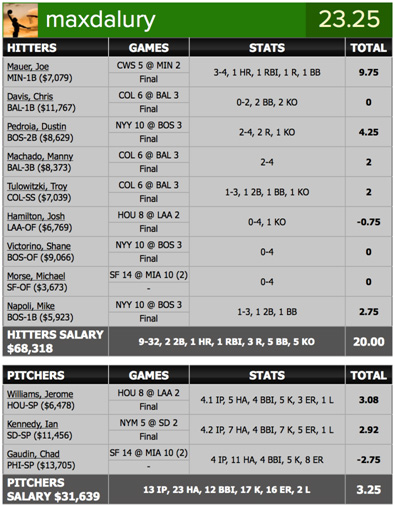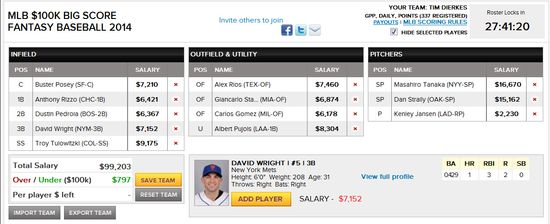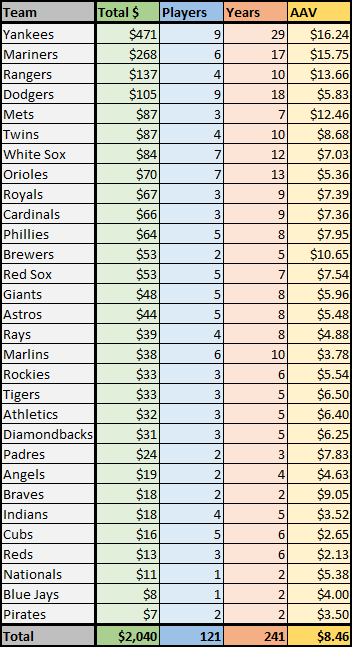Now that we are over a week into the season, the time is fast approaching when top prospects that have yet to accrue any MLB service time can safely be brought up without the sacrifice of a year of control for their team. With less than 172 days left in the season, players who have no prior MLB time can no longer reach a full year by straight-ahead counting. (Remember: a year of service is achieved at 172 days on the active roster or big league DL; while a season has more than 172 days, a player cannot accrue more than one year of service for each season.)
However, MLB rules provide that players accrue service time if they spend less than 20 days on optional assignment in a given year. Thus, we are still about a week and a half away from the point that prospects who are already on the 40-man (and thus currently on optional assignment) can be called up while still preserving six full seasons of future team control.
Looking at the Baseball America Top 100 prospects, the following top prospects (with rank and team) are in the minors at present, have yet to accrue any MLB service, and are projected by BA to be ready for MLB action at some point in the current season:
Position Players
Byron Buxton (#1, Twins); Oscar Taveras (#3, Cardinals); Javier Baez (#5, Cubs); Miguel Sano (#6, Twins); Kris Bryant (#8, Cubs); Gregory Polanco (#10, Pirates); Francisco Lindor (#13, Indians); Addison Russell (#14, Athletics); Maikel Franco (#17, Phillies); George Springer (#18, Astros); and Jonathan Singleton (#82, Astros).
Pitchers
Archie Bradley (#9, D'Backs); Jon Gray (#12, Rockies); Jameson Taillon (#22, Pirates); Kyle Zimmer (#23, Royals); Eddie Butler (#24, Rockies); Andrew Heaney (#30, Marlins); Alex Meyer (#45, Twins); Marcus Stroman (#55, Blue Jays); Eduardo Rodriguez (#65, Orioles); and Rafael Montero (#68, Mets).
Of course, several of those players — notably, Sano and Taillon, who are both out for the season — may not have any realistic shot at this point of seeing time in the bigs this year.
For those players, the real key is Super Two status. As MLBTR's Tim Dierkes wrote in October, qualification has landed between 2.122 and 2.146 years of service in recent years. To be safe, teams hoping to dodge an extra arbitration payday will want to wait until the calendar flips from May to June to promote the above-listed prospects.
Still other players have already seen some MLB time in years prior and are waiting in the minors for a chance at the bigs. Dylan Bundy (#15, Orioles; 15 days of service) and Jimmy Nelson (#96, Brewers; 27 days service) are both within several weeks of being ready for promotion without costing a year of future control, though the former is still working back from Tommy John. Others — Kevin Gausman (#20, Orioles; 71 days service); Matt Davidson (#72, White Sox; 50 days service); Jake Marisnick (#79, Marlins; 69 days service); and Allen Webster (#88, Red Sox; 44 days service) – would need to stay down for a good bit longer for their clubs to keep that extra season. That group will be among the most interesting names to watch, since it is easy to imagine their employers being tempted both to use them in the bigs and to keep their service clocks paused.
Then, of course, there are the players who have already seen time in the season's early going. The following players will surpass their first year of MLB service unless they are optioned down for much of the season (service shown as of start of 2014):
Position Players
Xander Bogaerts (#2, Red Sox; 42 days service); Nick Castellanos (#25, Tigers; 29 days service); Travis d'Arnaud (#38, Mets; 44 days service); Billy Hamilton (#43, Reds; 28 days service); Jackie Bradley (#50, Red Sox; 59 days service); Kolten Wong (#58, Cardinals; 45 days service); Chris Owings (#66, Diamondbacks; 27 days service); Marcus Semien (#91, White Sox; 27 days service); and Michael Choice (#98, Rangers; 29 days service).
Pitchers
Taijuan Walker (#11, Mariners; 31 days service); Yordano Ventura (#26, Royals; 13 days service); Carlos Martinez (#31, Cardinals; 73 days service); Erik Johnson (#63, White Sox; 27 days service); Jake Odorizzi (#67, Rays; 42 days service); Trevor Bauer (#83, Indians; 25 days service); and James Paxton (#99, Mariners; 27 days service).
Bradley, Semien, Choice, and Bauer (who was just promoted for one start) all have some chance of spending most of their years in the minors, though each could certainly earn a MLB spot. The other players listed all seem to be set up for ongoing, regular big league roles unless they falter.
These aren't all of the young players whose rise to the big leagues will be impacted by service time considerations, of course. But the above discussion should give you a fair idea of where others would fall, based upon their service time and development timeline.




